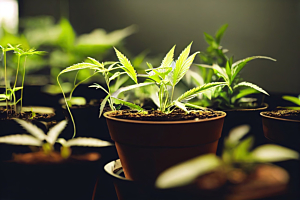For some, the goal is to produce cannabis plants that are as tall and as large in general as possible. Selecting normal cannabis seeds (as opposed to autoflowering) and choosing a good outdoor specimen is the way to go, if you’re all about the ‘bigger is better’ approach to cultivation.
But whether growing indoors or out, cannabis plant stretching is never a good thing. Irrespective of the cannabis strain you choose, stretching is an issue that can have an impact on the quality and quantity on the final harvest.
In fact, plants that become overly skinny and lanky can snap themselves in two, long before producing anything worth harvesting.
The good news being that it’s perfectly possible to reduce the risk of cannabis plant stretching:
1. Choose Your Strains Wisely
First of all, you’ll want to select an appropriate cannabis strain. If your priority is to keep things as short and squat as possible, stick with a high-quality indica-heavy strain. These types of plants are genetically predisposed to remain short and compact. By contrast, sativa-heavy strains exist right at the opposite end of the spectrum. Sativa plants have a tendency to grow much taller - sometimes higher than 3m - and can be therefore difficult to keep under control.
2. Focus on Air Circulation
It’s been learned over generations of cannabis cultivation that good air circulation is essential for growing strong and sturdy cannabis plants. By ensuring your plants are exposed to a gentle breeze at all times, they will naturally grow stronger than they would in still-air conditions. What’s more, the continuous provision of fresh air (and removal of stale air) can and will contribute to their healthy growth and development.
3. Position your Lighting Appropriately
The optimum distance between your lighting source and your cannabis plants will be determined by the type of lights you use and the power of the bulbs. In all instances, however, positioning your plants too far away from the lighting source they need will result in stretching. Rather than growing tall and strong, they will simply stretch out and become dangerously skinny. It’s therefore important to get into the habit of repositioning your grow lights at various times throughout the cultivation process, rather than just leaving them in one place.
4. Provide Plenty of Space
Ideally, each of your cannabis plants should be given sufficient space to allow light to reach each and every leaf of the plant. The greater the extent to which your plants are crowded with one another, the more likely they are to begin fighting vertically for light. All of which spells bad news for the health of your plants and the quality of the resulting harvest. If space is limited, it is always better to grow just a few cannabis plants in optimum conditions, rather than weak and low-producing cannabis plants in greater numbers.
5. Consider the ScrOG Method
Last but not least, one effective way of pretty much eliminating stretching from the equation is to go with the ScrOG method. In addition, pulling it off with ScrOG (in conjunction with LST or supercropping) can result in the production of enormous, dense and heavy buds from comparatively compact plants. It’s a relatively advanced cultivation technique that takes time, effort and careful monitoring, but nonetheless pays dividends for those who pull it off. When dealing with strictly limited space, ScrOG is a good way of putting every last inch to the best possible use.











